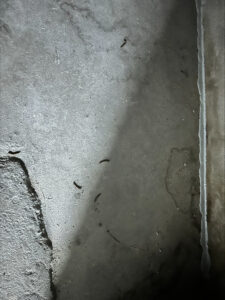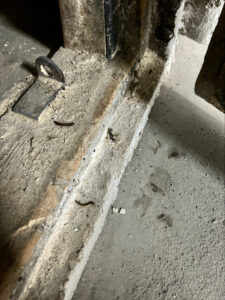Mealworms: A Chamber of Pest Secrets
CHALLENGE
Pest management programs in older buildings can be challenging. Older structures are full of pest conducive conditions, some readily visible and others not, and can be more vulnerable to pest infestations for multiple reasons.
Over time, structures develop cracks, gaps, or other openings that serve as convenient entry points for pests. Older construction practices and materials were not designed to keep pests out and, as a result, can make a structure more susceptible to damage or infestation by pests.
Furthermore, older buildings often have hidden or hard-to-reach areas that provide ideal breeding grounds for pests. Lack of proper ventilation or moisture control in older structures can also create environments that attract pests.
The combination of wear and tear, outdated construction practices, poor maintenance practices, and the accumulation of  conducive conditions over time makes older buildings more susceptible to pest issues.
conducive conditions over time makes older buildings more susceptible to pest issues.
Sprague Pest Solutions encountered just such a situation recently in a century old flour mill and storage facility with a problematic, and slightly mysterious infestation of the Yellow mealworm.
The staff at the audited facility observed Mealworm activity following a routine cleaning of an unused old storage room. The room, which was not part of the normal pest management service, was thoroughly inspected and performed exclusion work (i.e., sealing of cracks, crevices, etc.). Sprague’s route manager also applied an insect growth regulator to get rid of the pests. However, these steps did not eliminate the pest or identify the source of the infestation. A more in-depth investigation was needed.
The facility had occasional issues with stored product pests – confused flour beetles, red flour beetles and cigarette beetle larvae – but mealworms behave a little differently. When Sprague technical consultant Jeff Weier, BCE, a noted stored product pest expert, conferred with the team about where the pests were observed, he knew there was more than met the eye to solving the mystery.
“Mealworms are scavenger pests that need decomposing grain product material to survive,” said Weier. “The absence of visible moisture and organic debris, like sprouting grain inside the room shifted our focus.”
Sprague’s technical and QA team considered every aspect of the room’s environment, from the concrete walls to the basement below. Taking a 360-degree view of the room combined with extensive knowledge of the mealworm’s biology and behavior provided valuable clues.
The breakthrough came when the Sprague team, in partnership with the facility staff, took a closer look at the room’s location within the building’s layout. It was originally thought the room was surrounded by interior walls but its positioning (where the bulk plant and mill converged) featured an exterior wall that contained numerous pipe penetrations.
 These pipes allowed old feed material to accumulate out of sight, creating a hidden but ideal breeding ground for mealworms and other pests. Moreover, the extremely small exterior area where the pipes emptied was prone to moisture accumulation, exacerbated by the rain and snow, which further contributed to the problem.
These pipes allowed old feed material to accumulate out of sight, creating a hidden but ideal breeding ground for mealworms and other pests. Moreover, the extremely small exterior area where the pipes emptied was prone to moisture accumulation, exacerbated by the rain and snow, which further contributed to the problem.
“In general flour and grain mills are highly vulnerable to pests due to the constant presence of food and harborage sources,” said Sprague District Manager Lindsey Marker. “Compounding the issue in this case was the unique construction and age of the building as well as the surrounding area – a dog food plant on the same block and railroad tracks on one side – that added to the constant pest pressure.”
SOLUTION
The solution was as unconventional as the problem itself. The decision was made by the client to remove the room entirely as it served no functional purpose and was contributing to the pest issue. This drastic measure, coupled with targeted exterior treatments and removing the accumulated food debris, aimed to address the root cause rather than just the symptoms of the infestation.
The case underscores the importance of a holistic approach to pest control. It is not always the visible cracks or the obvious signs of moisture in a facility that are to blame. Sometimes, the source of a pest problem can be a complex combination of structural issues and environmental factors.
It also reinforces the critical need for accurate pest identification and factoring in pest biology and behavior into the process.
“If you know the biology and behavior of the pest you are trying to eliminate, it will lead you to the solution,” said Weier. “Don’t just look at where you see the pests, think of where they could be.”
The strong partnership between Sprague and the client contributed to identifying the root cause of the infestation and arriving at a solution. Marker said the client has invested time to educate Sprague staff on the milling process and how their equipment operates so they have a full understanding of the environment, a key to developing and executing an effect pest management program.
“We will go all hands-on deck with clients to solve their pest issues,” said Marker. “Those close partnerships allow us to look deeper at the issue and achieve the desired results. There is no finish line with our programs, we are always striving for continuous improvement.”
RESULT
The exclusion work, cleaning and exterior application of pesticides have drastically knocked down the mealworm population. The permanent solution will be the removal of the room which the client has scheduled once warm weather arrives.
